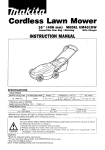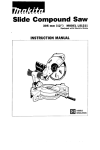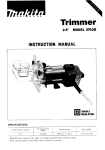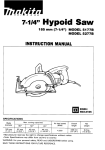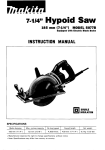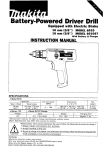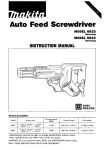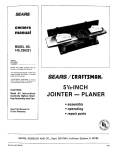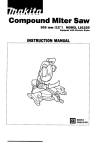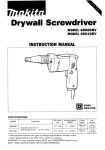Download Makita 2030N Instruction manual
Transcript
Planer-Jointer 320 mm (1242") MODEL 2030N With Electric Brake INSTRUCTION MANUAL SPECIFICATIONS I Auto feed Cutting width 320 mm 112~1'2"' I I Max. cutting depth 0 mm - 150 mm I O ' - 5-7/87 150 mm - 240 mm l5-7/8" - 9.1/2"1 High speed 2 mm 15/64") 1.5mm11/16"l Low speed 3 mm I118") 2 mm 15/64") Feed .weed Width 240 mm - 320 mm (9-112" - 12.1/2"1 High speed 1 mm15/128'1 1.5mm11/16,,) Table SIZE Fence size Auto feed 320mmx 600mm 112.112" x 23-518") Manual feed 155" x 1,MOmm l 6 - 1 / 8 ' x 59") 8m 5m 126ft.l (17ftI Stock height 12.7 mm - 185 mm ( 1 12" - 7-114") ~ 730mmx 105" Low speed __ 3 m m (1/8") Manual feed Feed rate /man 128-3/4" x 4-1/8"1 ~ No. of knives No load speed Overall length IW x L x H I Net weight 2 7,000 R/min. 780 mm x 1,500 mm x 775 mm 1 3 0 3 / 4 ' x 59" x 30-1 /2"l 150 kg 1330 Ibs) BEFORE CONNECTING YOUR TOOL TO A POWER SOURCE Be sure you have read all GENERAL POWER TOOL SAFETY RULES GENERAL SAFETY PRECAUTIONS (For All Tools) 1. KNOW YOUR POWER TOOL. Read the owner's manual carefully. Learn the 2. 3. 4. 5. 6. 7. 8. 9. IO. 11. 12. 13. 14. 15. 2 tools applications and limitations, as well as the specific potential hazards peculiar t o it. KEEP GUARDS IN PLACE and in working order. REMOVE ADJUSTING KEYS AND WRENCHES. Form habit of checking t o see that keys and adjusting wrenches are removed from tool before turning it on. KEEP WORK AREA CLEAN. Cluttered areas and benches invite accidents. DON'T USE IN DANGEROUS ENVIRONMENT. Don't use power tools in damp or wet locations, or expose them t o rain. Keep work area well lighted. KEEP CHILDREN AWAY. All visitors should be kept safe distance from work area. MAKE WORKSHOP KID PROOF w i t h padlocks, master switches, or by removing starter keys. DON'T FORCE TOOL. It will do the job better and safer at the rate for which it was designed. USE RIGHT TOOL. Don't force tool or attachment t o do a job for which it was not designed. WEAR PROPER APPAREL. Wear no loose clothing, gloves, neckties, rings, bracelets, or other jewelry which may get caught in moving parts. Nonslip footwear is recommended. Wear protective hair covering t o contain long hair. ALWAYS USE SAFETY GLASSES. Also use face or dust mask if cutting operation is dusty. Everyday eyeglasses only have impact resistant lenses, they are NOT safety glasses. SECURE WORK. Use clamps or a vise t o hold work when practical. It's safer than using your hand and it frees both hands t o operate tool. DON'T OVERREACH. Keep proper footing and balance at all times. MAINTAIN TOOLS WITH CARE. Keep tools sharp and clean for best and safest performance. Follow instructions for lubricating and changing accessories. DISCONNECT TOOLS before servicing; when changing accessories such as blades, bits, cutters, and the like. 16. REDUCE THE RISK OF UNINTENTIONAL STARTING. Make sure switch is in off position before plugging in. 17. USE RECOMMENDED ACCESSORIES. Consult the owner's manual for 18. 19. 20. 21. 22. 23. recommended accessories. The use of improper accessories may cause risk of injury t o persons. NEVER STAND ON TOOL. Serious injury could occur if the tool is tipped or if the cutting tool is accidentally contacted. CHECK DAMAGED PARTS. Before further use of the tool, a guard or other part that is damaged should be carefully checked t o determine that it will operate properly and perform its intended function - check for alignment of moving parts, binding of moving parts, breakage of parts, mounting, and any other conditions that may affect its operation. A guard or other part that is damaged should be properly repaired or replaced. DIRECTION OF FEED. Feed work into a blade or cutter against the direction of rotation of the blade or cutter only. NEVER LEAVE TOOL RUNNING UNATTENDED. TURN POWER OFF. Don't leave tool until it comes t o a complete stop. PROPER GROUNDING. This tool should be grounded while in use t o protect the operator from electric shock. EXTENSION CORDS: Use only three-wire extension cords which have threeprong grounding-type plugs and three-pole receptacles which accept the tool's plug. Replace or repair damaged or worn cord immediately. VOLTAGE WARNING: Before connecting the tool t o a power source (receptacle, outlet, etc.) be sure the voltage supplied is the same as that specified on the nameplate of the tool. A power source with voltage greater than that specified for the tool can result in SERIOUS INJURY t o the user - as well as damage t o the tool. If in doubt, DO NOT PLUG IN THE TOOL. Using a power source with voltage less than the nameplate rating is harmful t o the motor. 3 GROUNDING INSTRUCTIONS ALL GROUNDED, CORD-CONNECTED TOOLS: In the event of a malfunction or breakdown, grounding provides a path of least resistance for electric current t o reduce the risk of electric shock. This tool is equipped with an electric cord having an equipment-grounding conductor and a grounding plug. The plug must be plugged into a matching outlet that is properly installed and grounded in accordance with all local codes and ordinances. Do not modify the plug provided -if it will not fit the outlet, have the proper outlet installed by a qualified electrician. Improper connection of the equipment-grounding conductor can result in a risk of electric shock. The conductor with insulation having an outer surface that is green with or without yellow stripes is the equipment-grounding conductor. If repair or replacement of the electric cord or plug is necessary, do not connect the equipment-grounding conductor t o a live terminal. Check with a qualified electrician or serviceman if the grounding instructions are not completely understood, or if in doubt as t o whether the tool is properly grounded. This tool is intended for use on a circuit that has an outlet that looks like the one illustrated in Figure A. The tool has a grounding plug that looks like the plug illustrated in Figure A. A temporary adapter, which looks like the adapter illustrated in Figure B and C, may be used t o connect this plug t o a 2-pole receptacle as shown in Figure B if a properly grounded outlet is not available. The temporary adapter should be used only until a properly grounded outlet can be installed by a qualified electrician. The green-colored rigid ear, lug, etc. extending from the adapter must be connected t o a permanent ground such as a properly grounded outlet box. GROUNDING METHODS FIG. A t Grounding Pin 4 FIG. B -Cover of Grounded Outlet Box FIG. C Grounding Means ADDITIONAL SAFETY RULES 1. Don't use the tool in presence of flammable liquids or gases. 2. Handle the blades very carefully. 3. Check the blades carefully for cracks or damage before operation. Replace cracked or damaged blades immediately. 4. Be sure the planer blade installation bolts are securely tightened before operating. 5. Sharpen both blades evenly, or replace both blades or both cutterhead covers at the same time. 6. Never make jointing or planing cut deeper than 3.2 m m (1/8inch). 7. Remove nails and clean the workpiece before cutting. Nail, sand or other matter can cause blade damage. 8. Make sure the blade is not contacting workpiece before the switch is turned on. 9. Wait until the blades attain full speed before cutting. IO. 11. 12. 13. 14. 15. 16. Keep hands away from rotating parts. Stop operation immediately if you notice anything abnormal. Always switch off and wait for blades t o come t o a complete stop before adjusting any parts, cleaning out chips or approaching the blade. Never stick your finger into the chip chute. Chute may jam when cutting damp wood. Turn off the planer-jointer and then clean out chips with a stick. Do not touch blades right after operation, they may be extremely hot and could burn your skin. Don't abuse cord. Never yank cord t o disconnect from receptacle. Keep cord from heat, oil and sharp edges. Do not use auto-planer and jointer at the same time. Overloading of the motor can occur. 5 ADDITIONAL SAFETY RULES FOR JOINTER 1. Maintain the proper relationships of infeed and outfeed table surfaces and cutterhead blade path. 2. Do not perform jointing operations on material shorter than 140 m m (5-112 inches), narrower than 19 m m (3/4 inch), or less than 12.7 m m (112 inch) thick. 3.Do not perform planing operations on material shorter than 140 m m (5-1/2 inches), narrower than 19 m m (314 inch), wider than 155 m m (6-118 inches) or thinner than 12.7 m m (1/2 inch). 4. Support the workpiece adequately at all times during operation. 5. Do not back the work toward the infeed table. 6. Always use hold-downlpush blocks for jointing material narrower than 76.2 m m (3inches), or planing material thinner than 76.2 m m (3inches). SAVE THESE INSTRUCTIONS. ADDITIONAL SAFETY RULES FOR AUTO-PLANER 1. Two or more pieces of narrow but similar thickness stock can be passed through the auto-planer side by side. However, allow some spacing between the stock t o permit the feed rollers t o grip the thinnest piece. Otherwise, a slightly thinner piece could be kicked back by the cutterhead. WARNING For Your O w n Safety, Read Instruction Manual Before Operating Jointer 1. Wear eye protection. 2. Never perform jointing or planing operation with cutter head or drive guard removed. 3. Never make jointing or planing cut deeper than 3.2 mm (1/8 inch). 4. Always use hold-downlpush blocks for jointing material narrower than 76.2 m m (3inches), or planing material thinner than 76.2 m m (3inches). 5. Do not attempt t o perform an abnormal or little-used operation without study and the use of adequate hold-down1push blocks, jigs, fixtures, stops, etc. SAVE THESE INSTRUCTIONS. 6 HOW TO USE AUTO-PLANER 1. Adjusting depth of cut The maximum depth of cut changes in terms of the cutting speed and the width of the workpiece to be cut. See Fig. 1. Max. depth of cut _1 low speed 1 I=-. ---- 2 (5/64") 1 (5/128") nrn 0 (6") 150 (8") 200 mm (10") 250 (12") 300 Width Fig. 1 Insert the workpiece flush with the infeed table top so that the front end of the workpiece reaches a t least 20 to 30 mm (3/4 t o 1-1/8") beyond the depth gauge. Turn the crank handle and align the depth gauge with a graduation on the scale plate. This graduation indicates the depth of cut. Fig. 2 2. Dimensional adjustment The graduation on the scale bar aligning with the arrow i s the thickness of the workpiece after the cut. When cutting less than the maximum depth of cut, first align the graduation for the desired finished thickness with the arrow and then cut the workpiece. c I Fig. 3 7 3. Switchover of cutting speed Turn the speed change lever to the right for high speed, and to the left for low speed. CAUTION. Change speeds while the tool is running, but do not attempt to do so during an actual planing operation. Fig. 4 4. Chip deflector The ejecting distance of chips can be adjusted by means of the chip deflector. To eject the chips in the near area, set the chip deflector down. Chip deflector I CAUTION : When making heavy cuts, always set the chip deflector a t the upper position to prevent the chip chute from jamming. Fig. 5 8 JOINTER 1. Cutting depth Set the depth of cut with the depth adjustment knob while watching the graduation on the scale plate. Fig. 6 2. Fence angle (0 - 45') Set the depth of cut to "0" graduation. Loosen the thumb screws holding the fence in place. Pull out the fence by at least 25 mm (1") and tighten the thumb screws. Loosen the hex bolts ( A ) and (B) and tilt the fence. Fig. 7 At the desired angle, tighten the hex bolts, making sure that the bolt (A) is tightened first and the bolt (BI second. (Refer to Fig. 7). About 0.5 mm (1/64") clearance between, the lower edge of the fence and the table top is necessary for the correct setting. 3. Switch action To start the tool, the key and the ONbutton must be pressed in. Press the OFF-button to stop. The tool is switched off automatically when the electric current i s cut off. CAUTION : When not using the tool, remove the key. (This prevents unauthorized operation.) Fig. 8 9 OPERATION 1. Auto-Planer Determine the depth of cut and the cutting speed in terms of the width of the workpiece you intend to cut. Insert the workpiece flush with the table top. When cutting the long and heavy workpiece, lift up the end of the workpiece slightly a t the start and the end of cutting to avoid gouging or sniping a t the extreme ends of the workpiece. Two rollers are provided on top of the chip cover to enable quick, efficient return of the workpiece to the infeed table side. This i s especially convenient with two operators. I Return (for another pass) CAUTION : Stop the tool when the workpiece i s stalled. Keeping the tool running with a stalled workpiece causes the abnormal wearing of the feed rollers. Fig. 9 2. Jointer Placement of hands during feeding At the start of the cut, the left hand holds the workpiece firmly against the infeed table and fence, while the right hand pushes the workpiece toward the blade. After the cut is under way, the new surface rests firmly on the outfeed table. The left hand should press down on this part, a t the same time maintaining flat contact with the fence. The right hand presses the workpiece forward and before the right hand passes over the cutterhead it should be moved to the workpiece on the outfeed table. 10 Jointing edge Set the fence square with the table. Hold the best face of the workpiece firmly against the fence throughout the feed. (Fig. 10) CAUTION : Cover the cutterhead with the safety cover when the fence i s pulled out. (Fig. 1 1 ) . However, never touch the safety cover when the jointer i s running. Fig. 10 Jointing warped workpieces If the workpiece is dished or warped, press down when the workpiece moves over the outfeed table to obtain a smooth surface. (Fig. 10) Using hold-downlpush blocks For safety reasons, use hold-downlpush Push blocks Fig. 12 11 Direction of grain Avoid feeding workpiece into the Jointer against the grain as shown in Fig.13. The result will be chipped and splintered edges. Feed with the grain as shown in Fig. 14, to obtain a smooth surface. Wor kpiece Outfeed table lnfeed table Cutterhead Wrong feed -against the grain. Fig. 1: I- VCorrect feed - with the grain Fig. 1 4 12 CHANGING PLANER BLADES 1. Removing blades a1 Remove the screw on the outfeed side of the chip cover. Then open the chip cover. Fig. 1 Loosen the hex bolt with the wrench and lift off the safety guard assembly. Set the depth of cut for Jointer to maximum graduation. *Push the lock plate in the direction of the arrow and raise it slightly. Turn the knob to lock the drum. (Fig. 16) The drum can be locked a t the position shown in Fig. 17 or Fig. 18. Fig. 1( Bolt Drum cover Fig. 17 Blade Drum cover Fig. 1E 13 0 Lock the drum a t the position shown in Fig. 17 and loosen the hex bolts with the socket wrench. Remove the hex bolts and the drum cover. When removina the blade from the Auto-Planer, lock the drum a t the position shown in Fig. 18 and push the blade out with the screwdriver. I Fig. 19 .When removing the blade from the Jointer, release the drum lock and turn the knob to the position a t which the blade can be pushed out with the screwdriver. Fig. 20 2. Installing blades 0 Lock the drum a t the position shown in Fig. 18. 0 14 Insert the blade between the drum and the blade holder. Set the blade so that it will protrude by 2 mm (5/64") to 3 mm (1/8") from the drum. The holes of the blade should be aligned with the holes of the drum. Blade 2 m m - 3mm Blade holder .On the Auto-Planer, press down on both ends of the blades with wooden levelers. ~ Fig. 22 *On the Jointer, set the leveler on the outfeed table and slide it out over the blade edge. The edge of blade should just contact underside of leveler. Fig. 23 Lock the drum a t the position shown in Fig. 17. Mount the drum cover and tighten the hex bolts evenly and alternately. *After unlocking the drum, press down the wooden leveler on the blades slightly and turn the knob slowly in the direction of the arrow. (See Fig. 24). The wooden leveler should slide about 3 mm (1/8") to 5 mm (3/16") when the blade setting is perfect. Fig. 24 15 VARIOUS ADJUSTMENTS 1. Adjusting infeed/outfeed rollers (Auto-planer) NOTE : The planer infeed and outfeed rollers are factory adjusted. If you notice the adjustment is off, kindly do as follows. Use the wrench to loosen the installation nuts slightly. Turn the adjusting screw to obtain a level of from 0.1 to 0.3mm above the table surface. It i s relatively simple to make the setting so that a postcard can slip in and out between the roller and the leveler. After adjusting rollers, be sure to tighten installation nuts securely. A roller that protrudes too much will cause gouging or shiping in the workpiece and rough surfaces. Roller shaft Roller 3 mm Fig. 21 2. Extension roller adjustment Gently loosen the hex bolts, set a rule or yardstick on the table surface and adjust so that roller arm is slightly higher than the table. Tighten the hex bolts securely so that the roller arm surface is a t 90" to the column. 16 MAINTENANCE CAUTION : Always be sure that the tool is switched off and unplugged before attempting to perform inspection and maintenance. Replacing carbon brushes .Remove and check the carbon brushes regularly. Replace when they wear down to about 6 mm (1/4") or less. Keep the brushes clean and free to slip in the holders. Both brushes should be changed a t the same time. Use only Makita carbon brushes. U 6 m m (1/4") I Fig. 2Z Remove the screws that hold the chip cover and the switch cover. Set the speed change lever in the neutral position and remove the switch cover. Open the chip cover. Fig. 29 .Use a screwdriver to remove the brush holder cap as shown on the figure. Fig. 30 17 .Take out the worn brush, insert the new one and secure the brush holder cap. Fig. 31 Cleaning Always brush off dirt, chips and foreign matter adhering to roller surfaces, motor vents. Make sure that water or oil does not enter the motor. Fig. 3: Lubrication (periodic) Oil the chain (after removing the chain cover), the column moving parts (contact areas) and the crank handle. This periodic lubrication should be performed with machine oil. (Oiling should be done with tool turned off and unplugged.) I Remove chain guard to 011 I Fig. 33 18 Sharpening planer blades (In case of blade width 155 mm (6-1/8”)) 1. Remove the two wing nuts on the holder. 2. Set the blade A and blade B on the holder so that the heel of the blade will be flush against C and D surface of the holder respectively. 3. Tighten the wing nuts t o hold the blades in the holder. 4. Sharpen with the dressing stone keeping both blades contacting the dressing stone surface a t the same time. 1 Fig. 31 Wing n u t Blade B \ Dsurface\ I Fig. 3! Immerse dressing stone in water for 2 or 3 minutes before sharpening. Hold the holder so that blades both contact the dressing stone for simultaneous sharpening a t the same angle. Stock removal i s possible up to 7.5 mm (5/16”). Blades may be used down to 24.5mm (1”) width. Fig. 36 To maintain product SAFETY and RELIABILITY, repairs, any other maintenance and adjustment should be performed by Makita Authorized or Factory Service Centers, always using Makita replacement parts. 19 ACCESSORIES CAUTION : These accessories or attachments are recommended for use with your Makita tool specified i n this manual. The use o f any other accessories or attachments might present a risk of injury t o persons. The accessories or attachments should be used only i n the proper and intended manner. 0 Sharpening Holder (Part No. 123006-2) 0 Socket Wrench (13) (Part No. 782213-2) 0 Triangular Rule (Part No. 762001-3) 0 Wooden Levelers (Part No. 441021 -7) - Hex Wrench (Part No. 783202-0) *Push Block (Part No. 155508-0) 0 (+I 0 Replacement Blades Screwdriver (Part No. 783002-8) Width (mm) 16-118") .- . - . 155 -155 320 320 (6;1/8") (12-1/2") (12-1/2") Material 20 1 I [ I I 0 Hex Flange Hd. Bolt M8x 30 (Part No. 251690-4) Sprocket Set (Part No. 191605-8) Part No. 731021-8 731206-6 731035-7 731211-3 . . . Tungsten-carbide Dressing Stone 180-1200 Key (Part No. 741801-4) (Part No. 411447-7) Leveler Wrench (Part No. 41 1908-71 (Part No. 781202-4) 21 Seo -19-'84 320 mm (12-1/2") PLANER-JOINTER Model 2030N 22 US 23 Note: The switch and other part configurations may differ from country to country. 24 MODEL 2030N AiD Sep AtD DESCRIPTION 19-84 US DESCRIPTION MACHINE ~ 1 2 3 4 3 5 6 7 8 9 10 I1 16 2 2 3 17 2 1 1 1 1 IS 19 20 21 22 23 24 1 I 2 2 2 2 1 1 1 4 25 1 1 26 1 27 28 29 30 31 32 33 34 35 36 37 38 39 40 41 42 43 44 45 46 47 48 49 1 1 1 1 50 51 1 1 1 1 1 1 2 2 1 2 2 2 1 6 12 2 4 1 1 2 58 2 4 1 1 1 1 1 1 59 60 61 62 1 1 1 1 63 64 4 52 53 54 55 56 57 65 66 67 68 69 70 71 72 73 74 75 1 1 1 1 1 1 1 4 1 1 1 1 - Pan Head S ~ r e wM5x12 !Wilh Washer] Chip Cover Chip Blast Pan Head Screw M 5 x l 2 IWith Washer) Plane Bearing 10 Rod 1 0 - 4 0 0 Pan Head Screw M5x12 IWith Washer] Roller 2 6 - 3 7 5 Plane Bearing 10 Stop Ring E - 9 Switch Cover Switch Stop Ring E 9 Retaining Ring S 9 Spllny P,n 4 - 1 8 Rod 0 Ring 1 Lever 4 0 Countersunk Head Screw M4x10 !With Washeri supportsr Ball Bearing 609LLB Flat Warher 10 Gear Complete 11 - 16 71 Flat Washer 10 Ball Bearing 620311B Flat Washer 18 Compression Spring 21 Helical Gear 6 8 Gear Complete 13 Helical Gear 63 Compression Spring 21 Flat Washer 12 Brush Holder Cap Carbon Brush Motor Housing Insulation Washer Countersunk Head Screw M5x14 [With Washerl Pan Head Screw M5x16 [With Washer) Retainer L Chip Breaker Compresrlon Spring 4 Guide Bar Rivet 2 5 Name Plate Retainer R Countersunk Head Screw M5x14 IWith Washerl Pan Head Screw M5x16 [With Washer) Pan Head Screw M 5 x 3 0 IWtth Washerl v Pulley 9 - 3 M Brackel Ball Bearmg 6201110 Dust Seal 12 Fan 92 ARMATURE ASSEMBLY [With Item 55 - 601 Dust Seal 1 0 Ball Bearing 6200LlB FIELD ASSEMBLY Gear Housing Pan Head Screw M5xBO !With Washer) Flat Washer 14 Helical Gear 7 9 Woodruff Key 4 Driving Shaft Woodruff Key 4 Flat Washer 14 Gear Housing Cover Pan Head Screw M5x45 1WiIh Washer] Cham Cover Chain 3 5 - 7 4 Reiain8ng Ring S - 12 Sorocket 15 76 77 78 2 79 80 81 82 83 84 85 86 1 1 1 1 1 1 1 1 87 2 88 1 1 1 1 1 1 1 1 1 89 90 91 92 93 94 95 96 97 98 1 1 6 1 99 I00 I01 102 I03 I04 105 I06 107 IO8 I09 110 I11 112 4 113 2 2 2 2 I14 115 116 117 118 119 I20 121 122 123 124 I25 I26 I27 I28 129 130 131 132 133 I34 135 I36 137 I38 I39 I40 141 142 I43 44 45 I46 847 1 4 1 1 1 1 1 1 1 1 4 2 2 2 4 8 2 1 1 1 1 1 1 1 1 1 4 12 2 1 1 1 1 2 1 1 1 1 2 2 1 1 2 1 - - Pan Head Screw M5x12 IWilh Washerl Rerasnmy Ring S - 1 2 Sprocket 1 0 Chain Cover Stay Reraining Ring S - 1 2 Flat Washer 1 2 Needle Bearing 1212 Flat Washer 1 2 Bearing B O X Pan Head Screw M 5 i l 2 !With Washerl Strain Relief Pan Head Screw M5x95 !With Washerl Lock Plate Spring Pin 4 18 Sleeve 5 Flat Washer 6 Pan Head Screw M5x25 [With Washer] Spring Pin 4 - 2 4 Torsion Sprfng 12 Pan Head Screw M5x12 IWifh Warherl Strain Relief Countersunk Head Screw M6x20 lWnh Washerl Main Frame Spring Pin 8 - 7 0 Tension Core Pan Head Screw M5x20 lWiIh Washer) Tension Roller Sleeve 5 Torsion Spring 13 Flat Washer 6 Pan Head Screw M 5 x 2 0 [With Washer] Sprocket 15 Retaining Ring S - 12 Pan Head Screw M5x12 1WiIh Washer) Pan Head Screw M5x16 IWith Washerl Metal Cover B Plane Bearing 14 Woodruff Key 4 Roller45 310 Plane Bearing 14 Compression Spring 13 Metal Cover A Pan Head Screw M 5 x 1 6 lWith Washerl Pan Head Screw M5x12 lWiIh Washer1 Blade Holder 3 0 0 Key 5 Urethane Sleeve I O Poly V Bell 9 453 V Pulley 9 - 7 0 Hex Socket Head Bolt M5x16 Ball Bearing 6303LLB Ball Bearing 6303LLB Main Drum Planer Blade 320 Drum Cover 300 Hex Flange Head Bolt MBx3O Compression Spring 13 Retaining Ring S 12 Drum Cover Ruler Spring Pin 4 - 2 4 Pan Head Screw M5x16 !With Washerl Torsion Spring 14 Hex Bolt M6x12 A d p s i Bed Scale Plate Pan Head Screw M 4 x 1 0 !With Washer) Pan Head Screw M5x12 lWith Washerl Ruler Holder L Chip Guide Her Bolt M6x12 [With Washer) Safety cover 25 Sep.-19-84 MODEL 2030N 'itM $tDDESCRIPTION d;,'" $ZD DESCRIPTION MACHINE MACHINE ~ 148 149 150 151 152 153 154 155 156 157 158 159 160 161 162 163 164 165 166 167 166 169 170 171 172 173 174 175 176 177 178 179 180 181 182 183 184 185 186 187 180 109 190 191 192 193 194 195 196 197 198 199 200 201 202 203 204 205 206 207 208 209 210 211 212 1 4 2 2 1 1 1 4 1 1 1 1 1 1 1 1 2 2 4 4 8 4 4 1 1 2 4 4 2 1 1 1 1 4 2 1 2 2 2 2 1 1 4 2 1 1 2 1 1 1 1 1 1 1 2 2 2 2 2 2 2 4 2 4 8 - Ruler Holder R Hex Flange Head Bolt M8xZO Pan Head Screw M5x16 [With Washer) Ruler Bar L F i x Bed Spring Pin 4 - 3 2 Knob 40 Hex Bolt Max25 lWith Washer) Be" cover Ball Bearing 6203LL8 Sub Drum Ball Bearing 6203LLB Pan Head Screw M5x35 [With Washer1 Belt Cover Key 5 Planer Blade 155 Blade Holder 155 Drum Cover 155 Hex Bolt M10x35 Lesi Spring Hex Flange Head Bolt MBx30 Sleeve 10 Pan Head Screw M5x12 IWith Washer1 Hex Socket Head Bolt M5x18 Coupling Spring Pin 10-60 Spring Washer 12 Hex Bolt M12x50 Pan Head Screw M5x14 lWith Washer) Scale Plate sprmg PI" 4 - 12 + Binding Head Screw M8 Depth Gauge Countersunk Head Screw M5x12 IWith Washer) P0l"t Plate Spring Pin 5-24 Indication Label Hex Bolt Max38 Her Bolt MBx30 Tension Spring 6 pressure Plate Ruler Supporter Hex Bolt Max30 IWith Washer) Wing Bolt M6x15 Flat Washer 14 Bar Holder Hex Bolt Max30 lWith Warher) Flat Washer 14 Spring Pin 6-24 Adjust Pole Knob 70 Spring Pin 5-28 Indication Label Rod 12-125 Stop Ring E - 9 Roller Arm Plane Bearing 10 Roller 26-315 Rod 10-340 Plane Besrlng 10 Stop Ring E-9 Cap 6 0 Roller Arm Felt Ring 60 Hex Bolt M8x20 lWnh Washer) 213 214 215 216 217 218 219 220 221 222 223 224 225 226 227 228 229 230 231 232 233 234 235 236 237 238 1 4 4 1 1 1 1 1 5 1 1 1 1 4 4 4 4 2 2 4 1 239 240 241 243 244 245 246 247 248 249 250 251 252 253 254 255 2 56 257 258 259 260 261 262 263 264 265 266 268 269 270 271 272 273 274 275 276 277 278 1 2 1 2 2 1 1 1 1 2 2 1 1 1 2 2 1 1 1 1 1 1 1 1 1 1 2 1 2 2 2 2 1 1 2 1 1 1 1 1 1 1 4 - Note' The switch and other part SpeCifiCatiOnsmay differ from country to country. Table ~ B XNu1 M6 "an Head Screw M6x50 l e x NulM12 Spring Washer 12 :la1 Washer 12 3D"g 53 Handle Supporter Hex Bolt M6x35 IWith Washer) Thrust Needle Bearing 1520 Straight Bevel Gear 28 Screw TM25 Stable Bare 3olumn Snap Ring 55 3ellows Snap Ring 55 Hex Nut M10 'la1 Washer 10 Spring Pin 8 - 7 0 Stable Bars U t Washer 11 Hex Bolt M10x140 Pan Head Screw M5x12 [With Weshe0 Strain Relief CORD ASSEMBLY U s e m b l e d Cord Plug & Item 2391 Cord Guard Pan Head Screw M5x12 Strain Relief Hex BDII ~ 1 0 x 1 0 0 Flat Washer 11 - Bolt M10 Base Grip 30 Flat Washer 10 Flat Washer 10 Hex Nut M10 Handle 175 Woodruff Key 4 Split Pin 3 0-25 Hex Bolt MBx20 Compression Spring 16 Flat Washer 16 Handle Shaft Straight Bevel Gear 14 Retaining Ring S - 12 Woodruff Key 4 Pen Head Screw M5x14 lWith Washer) Scale Bar Plane Bearing 10 Roller 26-265 Plane BBarlng 10 Rod 10-315 Pan Head Screw M5x12 IWith Washer) Key Pan Head Screw M4x10 Hex Nut M10-17 Pan Head Screw M5x12 set Plate Pan Head Screw M5x10 Knob 20 Pan Head Screw M5x12 Spring Pin 4-18 Flat Washer 8 IWith Washer) lWith Washerl lWith Washer) lWith Washer) US ... ..... ..... .. .. ... . . . .. . . . . .. .... .. ..... .. .. ..-. .-. . .. .. .. MAKITA LIMITED ONE YEAR WARRANTY Warranty Policy Every Makita tool is thoroughly inspected and tested before leaving the factory. It is warranted to be free of defects from workmanship and materials for the period of ONE YEAR from the date of original purchase. Should any trouble develop during this one-year period, return the COMPLETE tool, freight prepaid, to one of Makita’s Factory or Authorized Service Centers. If inspection shows the trouble is caused by defective workmanship or material, Makita will repair (or at our option, replace) without charge. This Warranty does not apply where: repairs have been made or attempted by others: repairs are required because of normal wear and tear: The tool has been abused, misused or improperly maintained; alterations have been made to the tool. IN NO EVENT SHALL MAKITA BE LIABLE FOR ANY INDIRECT, INCIDENTAL OR CONSEQUENTIAL DAMAGES FROM THE SALE OR USE OF THE PRODUCT. THIS DISCLAIMER APPLIES BOTH DURING AND AFTER THE TERM OF THIS WARRANTY. MAKITA DISCLAIMS LIABILITY FOR ANY IMPLIED WARRANTIES, INCLUDING IMPLIED WARRANTIES OF “MERCHANTABILITY” AND “FITNESS FOR A SPECIFIC PURPOSE,” AFTER THE ONE-YEAR TERM OF THIS WARRANTY. This Warranty gives you specific legal rights, and you may also have other rights which vary from state to state. Some states do not allow the exclusion or Limitation of incidental or consequential damages, so the above limitation or exclusion may not apply to you. Some states do not allow limitation on how long an implied warranty lasts, so the above limitation may not apply to you. Makita Corporation 3-11-8, Sumiyoshi-cho, Anjo, Aichi 446 Japan 883441 - 065 PRINTED IN JAPAN 1991 - 8 - N



























